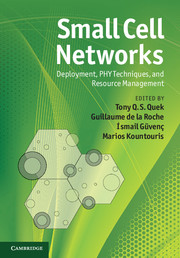Book contents
- Frontmatter
- Contents
- List of contributors
- Foreword by David Chambers
- Acknowledgments
- Acronyms
- 1 Small cell networks overview
- 2 Fundamentals of access control in femtocells
- 3 Coverage analysis using the Poisson point process model
- 4 Interference modeling for cognitive femtocells
- 5 Multiple antenna techniques in small cell networks
- 6 Physical layer techniques for cognitive femtocells
- 7 Femtocell coverage optimization
- 8 Random matrix methods for cooperation in small cell networks
- 9 Mobility in small cell networks
- 10 Cognitive radio resource management in autonomous femtocell networks
- 11 Decentralized reinforcement learning techniques for interference management in heterogeneous networks
- 12 Resource allocation optimization in heterogeneous wireless networks
- 13 New strategies for femto-macro cellular interference control
- 14 Femtocell interference control in standardization
- 15 Spectrum assignment and fairness in femtocell networks
- 16 Self-organization and interference avoidance for LTE femtocells
- Index
- References
11 - Decentralized reinforcement learning techniques for interference management in heterogeneous networks
Published online by Cambridge University Press: 05 May 2013
- Frontmatter
- Contents
- List of contributors
- Foreword by David Chambers
- Acknowledgments
- Acronyms
- 1 Small cell networks overview
- 2 Fundamentals of access control in femtocells
- 3 Coverage analysis using the Poisson point process model
- 4 Interference modeling for cognitive femtocells
- 5 Multiple antenna techniques in small cell networks
- 6 Physical layer techniques for cognitive femtocells
- 7 Femtocell coverage optimization
- 8 Random matrix methods for cooperation in small cell networks
- 9 Mobility in small cell networks
- 10 Cognitive radio resource management in autonomous femtocell networks
- 11 Decentralized reinforcement learning techniques for interference management in heterogeneous networks
- 12 Resource allocation optimization in heterogeneous wireless networks
- 13 New strategies for femto-macro cellular interference control
- 14 Femtocell interference control in standardization
- 15 Spectrum assignment and fairness in femtocell networks
- 16 Self-organization and interference avoidance for LTE femtocells
- Index
- References
Summary
Game theory (GT) is a mathematical tool that analyzes interactions among decision makers. Game theory is seen as a natural paradigm to study and analyze wireless networks where players compete for the same resources. The importance of studying the coexistence between macrocells and femtocells from a game theoretical perspective is multi-fold. First, as illustrated in Figure 11.1, by modeling the dynamic spectrum sharing among network players (macrocell base stations (MBSs), femtocell base stations (FBSs), mobile user equipment (MUE), and home user equipment (HUE)) as games, the behaviors and actions of players can be analyzed in a formalized structure, by which the theoretical achievements in GT can be fully utilized. Second, GT equips us with different optimality criteria for various spectrum sharing problems, which are of key importance when it comes to analyzing the equilibrium of the game. Third, the application of GT enables us to derive efficient distributed algorithms for self-organized networks relying only on partial information. In order to achieve this, the theory of strategic reinforcement learning is of utmost importance by allowing players to choose their optimal strategies and gradually learn from their environment through trial and error procedures. A comprehensive source of game theoretic approaches and their application to wireless communications can be found in [1].
- Type
- Chapter
- Information
- Small Cell NetworksDeployment, PHY Techniques, and Resource Management, pp. 260 - 279Publisher: Cambridge University PressPrint publication year: 2013

